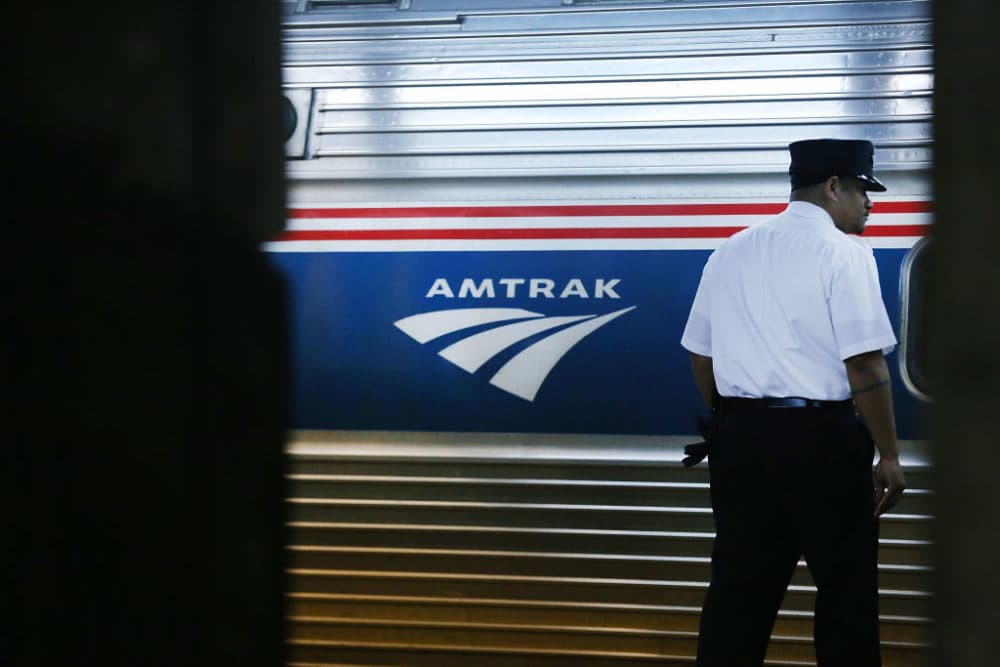Advertisement
View From The Top
Amtrak Could Turn A Profit In 2020 For The 1st Time Ever
Resume
Amtrak is on track to break even on its passenger railroad service next year for the first time in the company’s nearly 50-year history.
Founded in 1970, the national rail operator receives federal and state subsidies but the company is better known for losing money than turning a profit. Last week, the company reported an operating revenue of $3.3 billion for fiscal year 2019 — a 3.6% increase over the last year.
Richard Anderson, president and chief executive, says this marks Amtrak’s best operating performance ever. The company reported $29.8 million in losses — an 83% improvement over last year, he says — and has reduced operating losses by close to $400 million over the past year.
Anderson says he thinks the numbers reflect Amtrak employees’ dedication to the company’s mission and statutory obligation.
“Where we want to be as America's railroad is to cover all of our operating costs through our revenues,” he says, “and then use the grant that we receive from our owners, the United States government, to invest in the infrastructure, the rail infrastructure across America.”
Anderson, who also formerly served as CEO of Delta Air Lines, says it’s difficult for Amtrak to become profitable because the company has a backlog of debt from investments in infrastructure.
The company invested in the Hudson Tunnels in New York to repair damages caused by Hurricane Sandy in 2012 and to replace the century-old Portal Bridge in New Jersey.
Amtrak has between a $30 billion to $40 billion backlog of investments on infrastructure, Anderson says.
“There's just not been real investment in rail in America,” he says, “or a sufficient investment in Amtrak.”
Amtrak also reported a record of 32.5 million passengers for 2019 with most of the gains in ridership coming from Amtrak’s Northeast Corridor, which runs from Boston to Washington, D.C.
Anderson has said he wants to prioritize urban corridors over cross-country routes, but it’s not happening as fast as he would like — nor “as fast as the country needs it,” he says.
Amtrak is growing significantly on routes near congested highways that connect dense urban areas like San Diego to Los Angeles and Milwaukee to Chicago. Interstate 95 on the East Coast is now so congested that every community it passes through wants a rail stop, he says.
To meet this need, Anderson says the company plans to offer more differentiated products on the same line, a system used in “much more developed, well-operated passenger rail systems” like in Europe and Asia.
For example, the company would run a nonstop train from Boston to New York, a train that makes a handful of stops in-between and a train that stops at almost every station on the route, he says.
“We are only going to have more road congestion. The interstate highway system is not going to be able to be expanded and we can't afford to expand it really,” he says. “We can't put all those cars on the road. And Amtrak is the best environmental answer.”
On top of growing ridership and cutting losses, the company made notable safety improvements. A series of high-profile crashes prompted the company to crack down on safety.
Anderson says there were no employee or customer deaths this fiscal year. The rate of customer incidents went down 26% and there was a 72% reduction in serious employee injuries, he says.
In the next fiscal year, Anderson says the company hopes to address the challenges of operating on host railroads shared with freight trains that throw off Amtrak’s schedules.
The host railroads have been obligated to give the company preference over freight trains so Amtrak can run on time, but that statute has not been enforced, he says.
“That's really a challenge for a business that sells reliability and sells saving time,” he says. “In order for us to be a reliable service provider to people all over the country, we have to be able to run on time.”
The company is also struggling with funding and design flexibility — two things it needs to introduce new services that can meet demand in high-volume areas, he says.
Because of the complex legal structure that Amtrak operates under, Anderson says the company needs thoughtful leadership in Congress, the Department of Transportation and state governments to help plan the future of the American railroad system.
“Our biggest challenge is I go testify in Congress and all we talk about is French toast on dining cars or food,” he says. “We aren't talking about the really big infrastructure issues and transportation congestion issues that all the people in this country want a solution for.”
Francesca Paris and Chris Bentley produced and edited this interview for broadcast with Peter O'Dowd. Allison Hagan adapted it for the web.
This segment aired on November 15, 2019.

